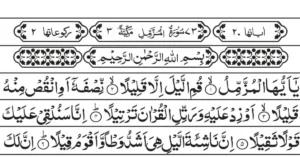Salah is one of the five pillars of Islam. All Muslims past the age of puberty must perform Salah five times daily. Due to its obligatory nature, performing your prayers accurately and authentically is important. This brief guide is designed to help beginners learn how to pray Salah according to Sunnah.
In this guide, we will walk you through each step of Salah, from making the intention (niyyah) to the final salutation (tasleem), ensuring that you perform every step of the prayer correctly. We will also cover the specific recitations (and tasbeehat e namaz) for each part of the prayer to help you deepen your connection with Allah Almighty. By following this guide, you will fulfill your religious duty and enhance your humility and devotion during Salah.
Praying Salah accurately is important because it is a direct link between you and Allah (SWT), a moment where you express your devotion and seek His guidance. Performing Salah according to the Sunnah, following the example of the Prophet Muhammad (PBUH), ensures that your prayer is accepted and rewarded in the best possible way.
Understanding the Different Components of Salah
Salah consists of various components that must be performed correctly to ensure that the prayer is valid. These components include:
- Niyyah (Intention)
- Takbeer (Saying ‘Allahu Akbar’)
- Qiyaam (Standing)
- Rukoo (Bowing)
- Sujood (Prostration)
- Jalsa (Sitting between prostrations)
- Tashahhud (Sitting for attahiyat)
- Tasleem (Salutation)
Understanding these components and their significance is crucial for performing Salah properly.
Requirement of Ghusl, Wudu, and Clothing
When you intend to pray Salah, it is important to ensure that certain conditions are met. It is necessary to ensure that you are in a state of physical and spiritual cleanliness.
- Ghusl: This involves a full-body purification and is required after specific conditions such as sexual activity or menstruation. For more details, read our blog Ghusl: The Ritual and Spiritual Purity.
- Wudu: Ablution is necessary to clean specific parts of the body and is required before each Salah. For detailed steps, read our blog How To Perform Wudu According To Sunnah.
- Clothing: Clothing must cover the ‘awrah.
- For men, this means from the navel to the knees,
- For women, it means the whole body except the face and hands.
- It is important that clothing is clean and modest.
Prescribed Times for Salah
We must pray Salah at five set times during each day and night:
- Fajr: Before dawn until just before sunrise.
- Dhuhr: After midday until mid-afternoon.
- Asr: Late afternoon until just before sunset.
- Maghrib: Just after sunset until dusk.
- Isha: Nightfall until dawn.
You can easily find the correct Salah times for your location by using an app or website. Or you can click the link to find detailed instructions about the appropriate times of each salah.
Preparing for Salah – Making Intention and Facing the Qibla
In order to prepare for Salah, it is important to have a sincere intention (niyyah) in your heart to perform the prayer solely for the sake of Allah (swt). This can be done in either Arabic or your own language. Additionally, make sure to face the Qibla, which is the direction of the Kaaba in Mecca.
For example, if you are about to pray Asar Salah, you can say, “I intend to pray the (four) Rak‘at of Salatul (Asar) for Allah facing the Ka‘bah.“
Make sure to replace the parts in brackets with the correct number of Rak‘ats (units of prayer) and the specific Salah you are about to perform.
Note: It's important to understand that if you are traveling on a ship or airplane and fear that the time of prayer will end before you reach a place where you can determine the direction of the Ka'bah, you can offer Salat without facing the Ka'bah.
However, it is recommended that you face the Ka'bah at least during the takbeer of ihram (saying "Allahu Akbar" at the beginning of Salat).
Beginning Salah – Reciting the Takbeer and Raising Hands
Ensure your prayer area is clean, and put down your prayer mat facing the direction of the Qiblah. Start in a standing position with your feet shoulder-width apart.
Raise your hands up to your earlobes for men, and shoulders for women, while saying ‘Allahu Akbar’. This means ‘Allah is the Greatest’. Your prayer has now started.
Place your right hand over your left, just below the navel. Women should place their hands over their chest.
Standing in Salah – Reciting Surah Al-Fatiha and Adding a Surah
Recite Sanaa: After Takbir and crossing your hands, begin with the recitation of thana/Sanaa.
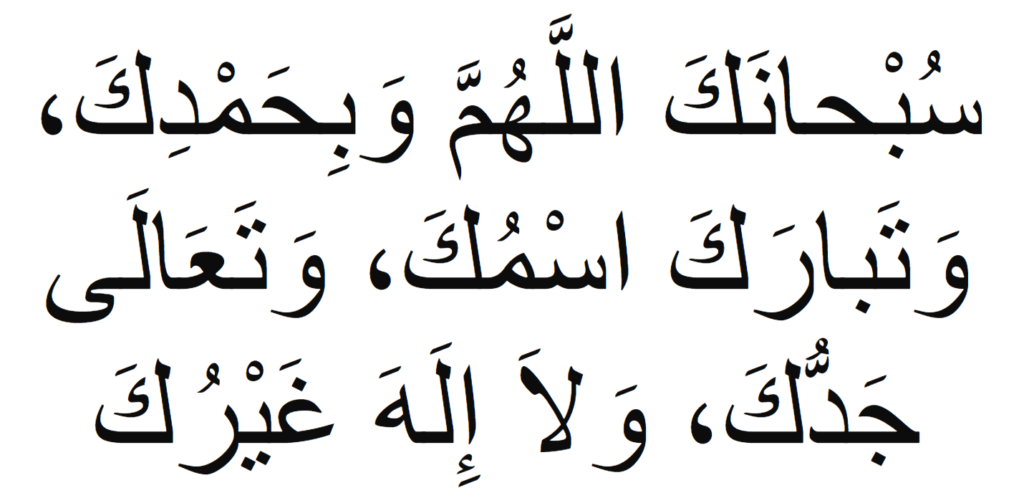
Recite Tauz or Ta’awwudh and continue with saying bismillah.
And then, Recite Surah Al-Fatiha. This is the opening chapter of the Quran and must be recited in every unit of Salah.
At the end of reciting Surah Fatiha say Ameen.
Add Another Surah: Recite a portion of the Quran (e.g., Surah Ikhlas).
Note: The minimum recitation is three verses, or one long verse which is equal in length to three short verses. However, it is better to recite a complete Surah.
Note: This method of reciting Surah Al-Fatiha and adding another Surah is valid when you are praying alone, and not in congregation. When you pray Salah in a congregation, there are different rules for Surah Al-Fatiha and adding other Surahs.
To understand these conditions and how to pray Salah in the congregation, read our blog Congregational Prayer: Conditions, Leadership, and Rulings.
Rukoo and Sujood – Bowing and Prostrating in Salah
Say Allahu Akbar and bend down for ruku. In this position, keep your head and back aligned, and your eyes focused on the ground. Place your fingers and palms on your knees.
Here recite Tasbeeh three times or any odd number of times you like.

Then you stand up fully straight again. And say,

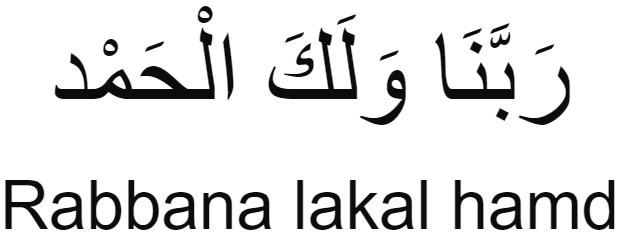
While coming up from ruku your hands should be at your sides and not crossed at the chest.
Say Allahu Akbar and go down for sajdah (prostration). Ensure that your forehead, nose, palms of both hands, knees, and toes pointing forward are all touching the floor.
Recite Tasbeeh three or any odd number of times you like in this position.

Rise up from sujud and sit for a moment
Say Allahu Akbar as you rise from sujud and then sit on your left leg. Your left foot will rest on the floor while your right foot is upright. Place your hands on your knees. This position is called Jalsa.
When you are in this position of Jalsa, it is recommended to ask Allah for forgiveness. A simple and easy dua you can say is Rabbighfir li (O my Lord! Forgive me)
You can also recite Allaahumma-ghfir lee warhamnee wajburnee, warfa’nee, wa 'aafinee war'zuqnee (O Allah, forgive me, have mercy on me, strengthen me, raise me in status, pardon me and grant me provision).
Say Allahu Akbar and go for your second sujud, recite Subhana Rabbiyal A’la tasbeeh three times. After saying Allahu Akbar stand back up and cross your arms just as before.
This represents one complete rakat of salah.
Perform the second rakat the same, except you do not need to recite subhanaka. When you complete the second sujood of the second rakat stay seated in the position of Jalsah.
Sitting for Tashahhud and Durood
After completing the second rakat of your salah, you will now sit and recite Tashahhud silently:
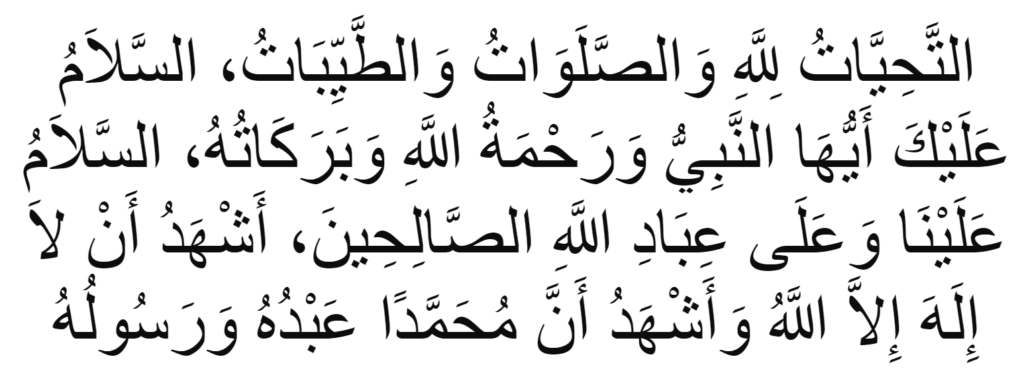
When you read the shahada (testimony of faith – ashhadu alla ilaha illallah wa ashhadu anna muhammadan abduhu wa rasuluhu) ball up your right hand into a fist and raise your index finger. This symbolizes the tawhid or oneness of Allah.
At this point, if the salat consists of more than two rakat you would say the takbir, i.e. Allahu akbar, and begin the third rakat.
If the salah only consists of two rakats then you would continue with the following supplication known as Salawat or Durood.
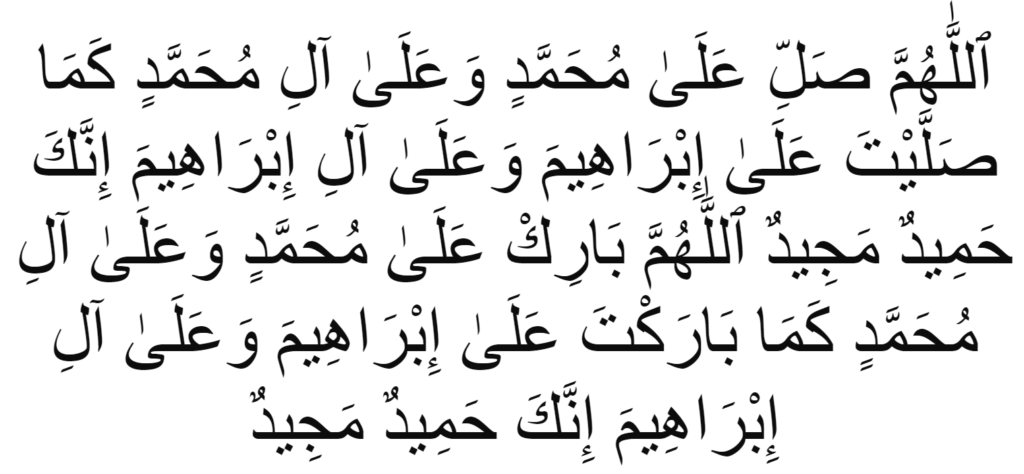
It is then highly recommended to recite some supplications (du‘a). One very simple and comprehensive one is, ’Rabbana aatina fid-dunya hasanataw wa fil-aakhirati hasantaw wa qina ‘adhaaban Naar’.
This means, ‘O our Lord give us good in this world and good in the hereafter and protect us from the punishment of the Fire.’
Completing Salah – Making Tasleem and Additional Supplications
Tasleem (Salutation):
- Turn your head to the right and say “Assalamu Alaikum wa Rahmatullah” (Peace and mercy of Allah be upon you).
- Turn your head to the left and repeat the salutation.
Additional Supplications:
- After completing Salah, you may recite various supplications and make personal du’as.
Common Mistakes to Avoid in Salah and Tips for Improving Concentration
Common Mistakes:
While we pray Salah, it is essential to be mindful of common mistakes that may compromise the validity and sincerity of the prayer.
- Not performing Wudu correctly.
- Rushing through the prayer.
- Incorrect pronunciation of recitations.
- Lacking focus and concentration
Tips for Improving Concentration (Khushu o Khuzu):
To enhance your Salah experience and bring Khushu o Khuzu into it, it is advisable to avoid the above-mentioned mistakes, and:
- Understand the meaning of what you are reciting.
- Remove distractions from your prayer space.
- Focus on your intention and imagine standing before Allah.
Closing Thoughts
In conclusion, Salah is a special way to connect with Allah (swt). By following the example of the Prophet Muhammad (pbuh) and praying with mindfulness and devotion, you can strengthen your faith and nourish your soul.
I hope this guide helps you pray Salah with sincerity and humility, seeking the pleasure and guidance of Allah (swt) in every part of your prayer.





